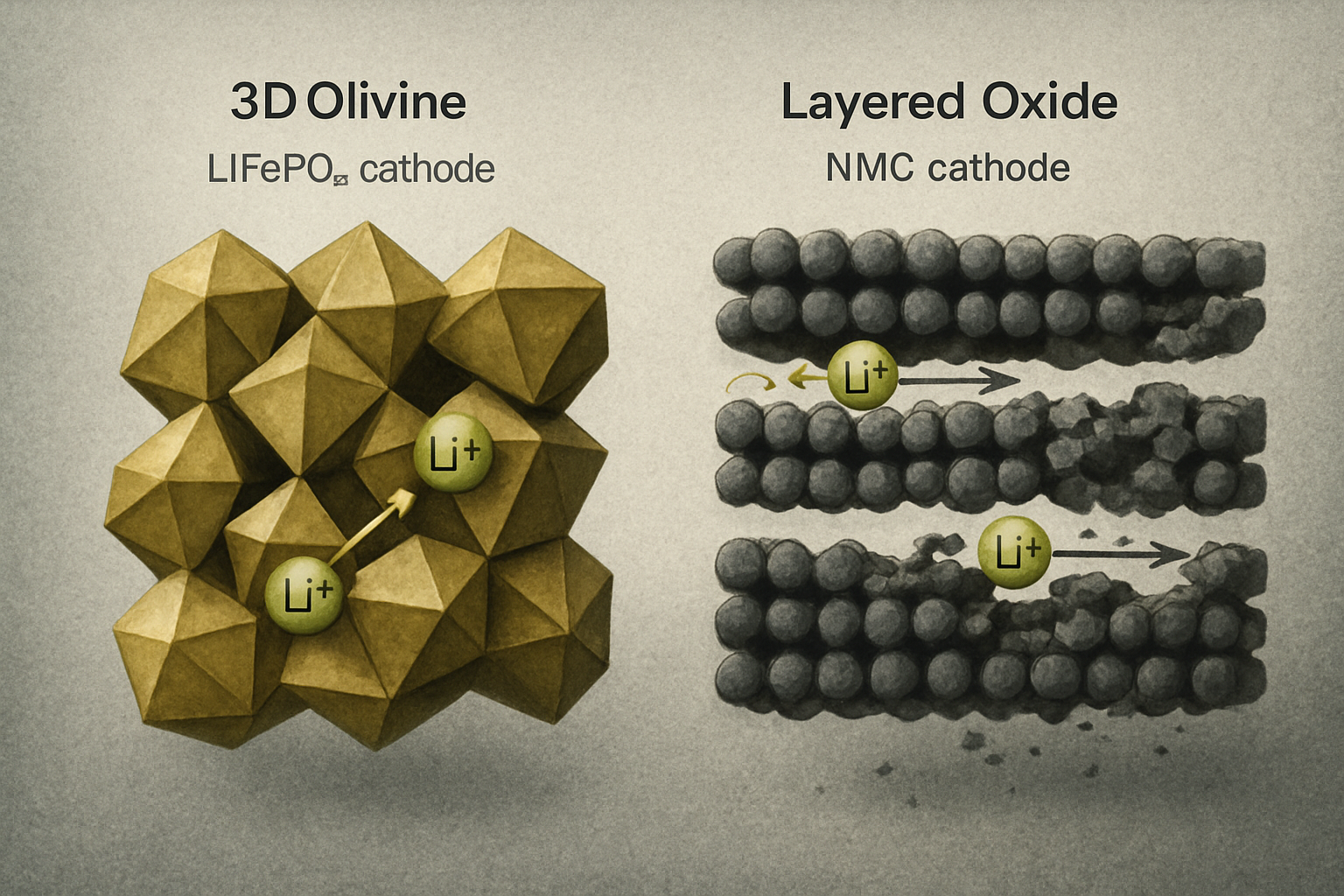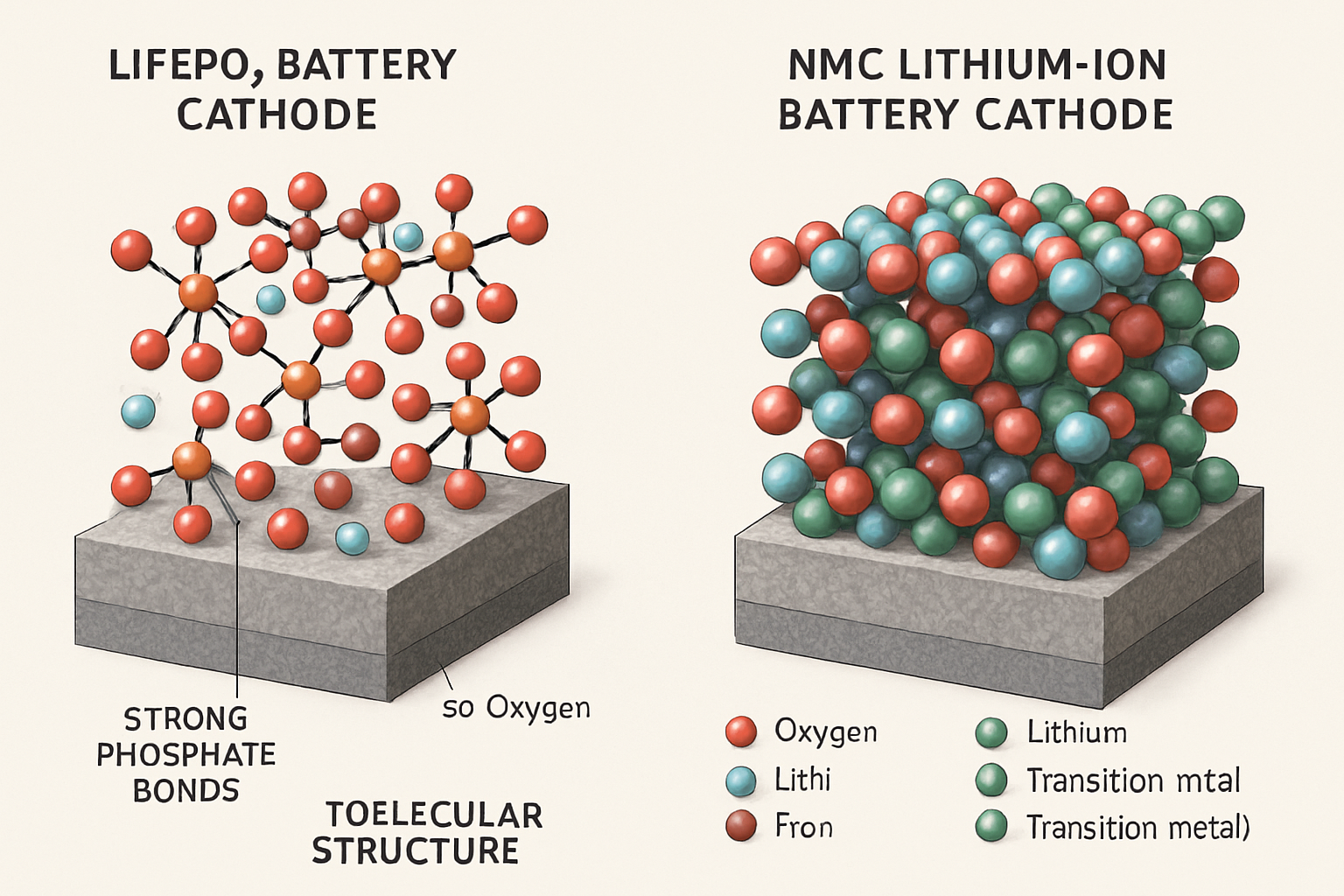Selecting the right battery for a solar energy system is a critical decision that impacts safety, performance, and long-term financial value. While many technologies fall under the 'lithium-ion' umbrella, two chemistries stand out for solar storage: Lithium Iron Phosphate (LiFePO4) and Nickel Manganese Cobalt (NMC). Understanding their fundamental differences is key to making a confident investment in your energy independence.
The Foundation: What Sets LiFePO4 and Other Lithium-Ion Chemistries Apart?
The core distinction between LiFePO4 and other lithium-ion batteries like NMC lies in their cathode material. This single component dictates the battery's primary characteristics, from stability and lifespan to energy density. The International Energy Agency (IEA) notes that while both chemistries are vital, LFP is rapidly becoming the standard for stationary storage due to its favorable characteristics.
The Chemistry of Stability: LiFePO4's Olivine Structure
LiFePO4 batteries use a unique, crystal-like olivine structure. The powerful covalent bonds between phosphorus and oxygen atoms create an exceptionally stable molecular foundation. This inherent stability makes the battery highly resistant to overheating and stress, which is a significant advantage for a system installed in a home or business.
The Chemistry of Energy Density: NMC and Other Variants
In contrast, NMC batteries use a layered oxide structure combining nickel, manganese, and cobalt. This chemistry is engineered to maximize energy density, meaning it can store more energy in a smaller and lighter package. This trait has made NMC a popular choice for electric vehicles (EVs) and portable electronics, where space and weight are primary design constraints.
Safety First: A Deep Dive into Thermal Stability
For any home energy storage system, safety is non-negotiable. The chemical stability of a battery directly relates to its risk of thermal runaway, a dangerous condition where a battery enters an uncontrollable, self-heating state.
LiFePO4: The Cooler Head in the Room
LiFePO4 chemistry is significantly less prone to thermal runaway. Its decomposition temperature—the point at which the chemistry starts to break down—is around 270°C (518°F). Furthermore, its stable structure does not release oxygen during decomposition, a key element that can fuel a fire. This makes LiFePO4 an inherently safer choice for residential and commercial solar storage applications.
Other Lithium-Ion Chemistries: A Balancing Act
NMC batteries have a lower thermal runaway threshold, typically around 210°C (410°F). Their higher energy density makes them more susceptible to overheating if damaged, overcharged, or exposed to extreme temperatures. While advanced Battery Management Systems (BMS) are effective at mitigating these risks, the fundamental chemistry of LiFePO4 provides a superior level of safety from the start.
Beyond Day One: Evaluating Lifespan and Cycle Life
A solar battery is a long-term asset. Its true value is measured not just by its initial capacity but by how well it performs over thousands of charge and discharge cycles.
Cycle Life: How Many Times Can You Charge?
Cycle life refers to the number of full charge-discharge cycles a battery can endure before its capacity degrades to a specific level, usually 80% of its original rating. Here, LiFePO4 batteries have a decisive advantage. They are known to deliver between 3,000 and 8,000 cycles, and sometimes more, depending on the depth of discharge and operating conditions. NMC batteries typically offer 1,000 to 2,000 cycles under similar usage. This extended lifespan makes LiFePO4 a more durable and reliable technology for daily solar energy cycling.
Energy Density: Power in a Smaller Package
NMC batteries offer higher specific energy, ranging from 150-220+ Wh/kg compared to LiFePO4's 90-160 Wh/kg. This means an NMC battery can be smaller and lighter than a LiFePO4 battery of the same capacity. While this is a critical factor for EVs, it is far less important for a stationary home battery system, where the slightly larger footprint of a LiFePO4 system is a minor trade-off for major gains in safety and longevity.
Efficiency and Power Delivery
LiFePO4 batteries also demonstrate high charging efficiency, often between 95-98%. This means less energy is lost during the process of storing and retrieving solar power. They maintain a stable voltage across the discharge curve, ensuring consistent power delivery to your appliances. For a detailed look at how these metrics impact real-world use, an ultimate reference on solar storage performance provides useful benchmarks.
Looking at the Numbers: Upfront Cost vs. Long-Term Value
While the initial purchase price is a consideration, a smarter financial evaluation focuses on the total cost of ownership over the battery's lifetime. This is often measured by the Levelized Cost of Storage (LCOS), which calculates the cost per kilowatt-hour delivered over the battery's entire lifespan.
| Feature | LiFePO4 Battery | NMC Lithium-Ion Battery |
|---|---|---|
| Safety (Thermal Runaway) | ~270°C (518°F) | ~210°C (410°F) |
| Cycle Life (80% DoD) | 3,000 - 8,000+ cycles | 1,000 - 2,000 cycles |
| Energy Density | 90 - 160 Wh/kg | 150 - 250+ Wh/kg |
| Key Advantage | Superior Safety & Longevity | Higher Energy Density |
Although LiFePO4 batteries can sometimes have a slightly higher upfront cost, their significantly longer cycle life means they deliver far more energy over their lifespan. This results in a much lower LCOS, making LiFePO4 the more economical investment in the long run. As the International Renewable Energy Agency (IRENA) has noted, falling costs and technological improvements continue to make renewables and storage the most competitive energy sources.
Making the Right Choice for Your Energy Independence
When all factors are considered, the choice becomes clear. While NMC and other high-energy-density lithium-ion chemistries are excellent for portable applications, their priorities do not align with the needs of stationary solar storage. LiFePO4 technology offers a superior combination of safety, longevity, and long-term value that is unmatched for home and business energy systems. By prioritizing chemical stability and durability, a LiFePO4 battery provides the peace of mind and reliable performance needed to achieve true energy independence.
Disclaimer: This article is for informational purposes only and does not constitute financial or investment advice. Consult with a qualified professional before making any decisions about your energy system.
Frequently Asked Questions
Is LiFePO4 a type of lithium-ion battery?
Yes, LiFePO4 (Lithium Iron Phosphate) is a specific type of lithium-ion battery. The term 'lithium-ion' refers to a broad family of batteries that use different cathode materials. LiFePO4 is one such cathode material, alongside others like NMC (Nickel Manganese Cobalt).
Can I use any lithium-ion battery for my solar panel system?
While technically possible, it is not recommended. Batteries designed for portable electronics or electric vehicles have different performance characteristics. For solar storage, you need a deep-cycle battery designed for repeated, deep charging and discharging. LiFePO4 batteries are engineered specifically for this purpose, offering the safety and longevity required for a home energy storage system.
Why is energy density less important for home solar storage?
Energy density refers to how much energy can be stored in a given weight or volume. For applications like smartphones or electric cars, high energy density is crucial to keep the device light and compact. For a home battery storage system, which is stationary, the physical size and weight are far less critical than factors like safety, operational lifespan, and the total cost of ownership over decades. A slightly larger, heavier battery that is safer and lasts three to four times as long is a better long-term investment.





Leave a comment
All comments are moderated before being published.
This site is protected by hCaptcha and the hCaptcha Privacy Policy and Terms of Service apply.